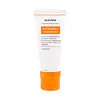What's inside
What's inside
 Key Ingredients
Key Ingredients

No key ingredients
 Benefits
Benefits

 Concerns
Concerns

 Ingredients Side-by-side
Ingredients Side-by-side

Water
Skin ConditioningPotassium Cocoyl Hydrolyzed Oat Protein
Skin ConditioningGlycerin
HumectantCocamidopropyl Betaine
CleansingPotassium Cocoyl Glycinate
PEG-120 Methyl Glucose Dioleate
EmulsifyingButylene Glycol
HumectantHippophae Rhamnoides Extract
MaskingXanthan Gum
EmulsifyingHouttuynia Cordata Extract
Skin ConditioningPanthenol
Skin ConditioningSodium PCA
HumectantDipotassium Glycyrrhizate
HumectantChlorphenesin
AntimicrobialAllantoin
Skin ConditioningDisodium EDTA
Capsicum Annuum Extract
MaskingDaucus Carota Sativa Extract
PerfumingWater, Potassium Cocoyl Hydrolyzed Oat Protein, Glycerin, Cocamidopropyl Betaine, Potassium Cocoyl Glycinate, PEG-120 Methyl Glucose Dioleate, Butylene Glycol, Hippophae Rhamnoides Extract, Xanthan Gum, Houttuynia Cordata Extract, Panthenol, Sodium PCA, Dipotassium Glycyrrhizate, Chlorphenesin, Allantoin, Disodium EDTA, Capsicum Annuum Extract, Daucus Carota Sativa Extract
Water
Skin ConditioningGlycerin
HumectantCocamidopropyl Betaine
CleansingPotassium Laureth Phosphate
EmulsifyingSodium C14-18 Olefin Sulfonate
CleansingTrehalose
HumectantSodium Chloride
MaskingPhenoxyethanol
PreservativeDisodium Cocoyl Glutamate
CleansingMethyl Gluceth-20
HumectantSodium PCA
HumectantCitric Acid
BufferingButylene Glycol
HumectantInulin
Skin ConditioningDecylene Glycol
Skin ConditioningSaccharide Isomerate
HumectantNiacinamide
SmoothingTetrasodium EDTA
Sodium Sulfate
1,2-Hexanediol
Skin ConditioningCentella Asiatica Leaf Extract
Skin ConditioningCitrus Paradisi Fruit Extract
Skin ConditioningFructose
HumectantPropylene Glycol
Humectant2,3-Butanediol
HumectantCeramide NP
Skin ConditioningCeramide Ns
Skin ConditioningSodium Citrate
BufferingSodium Hyaluronate
HumectantHydrogenated Lecithin
EmulsifyingGlyceryl Stearate
EmollientCeramide As
Skin ConditioningCholesterol
EmollientCeramide EOP
Skin ConditioningCeramide AP
Skin ConditioningEthylhexylglycerin
Skin ConditioningWater, Glycerin, Cocamidopropyl Betaine, Potassium Laureth Phosphate, Sodium C14-18 Olefin Sulfonate, Trehalose, Sodium Chloride, Phenoxyethanol, Disodium Cocoyl Glutamate, Methyl Gluceth-20, Sodium PCA, Citric Acid, Butylene Glycol, Inulin, Decylene Glycol, Saccharide Isomerate, Niacinamide, Tetrasodium EDTA, Sodium Sulfate, 1,2-Hexanediol, Centella Asiatica Leaf Extract, Citrus Paradisi Fruit Extract, Fructose, Propylene Glycol, 2,3-Butanediol, Ceramide NP, Ceramide Ns, Sodium Citrate, Sodium Hyaluronate, Hydrogenated Lecithin, Glyceryl Stearate, Ceramide As, Cholesterol, Ceramide EOP, Ceramide AP, Ethylhexylglycerin
Ingredients Explained
These ingredients are found in both products.
Ingredients higher up in an ingredient list are typically present in a larger amount.
Butylene Glycol (or BG) is used within cosmetic products for a few different reasons:
Overall, Butylene Glycol is a safe and well-rounded ingredient that works well with other ingredients.
Though this ingredient works well with most skin types, some people with sensitive skin may experience a reaction such as allergic rashes, closed comedones, or itchiness.
Learn more about Butylene GlycolCocamidopropyl Betaine is a fatty acid created by mixing similar compounds in coconut oil and dimethylaminopropylamine, a compound with two amino groups.
This ingredient is a surfactant and cleanser. It helps gather the dirt, pollutants, and other impurities in your skin to be washed away. It also helps thicken a product and make the texture more creamy.
Being created from coconut oil means Cocamidopropyl Betaine is hydrating for the skin.
While Cocamidopropyl Betaine was believed to be an allergen, a study from 2012 disproved this. It found two compounds in unpure Cocamidopropyl Betaine to be the irritants: aminoamide and 3-dimethylaminopropylamine. High-grade and pure Cocamidopropyl Betaine did not induce allergic reactions during this study.
Learn more about Cocamidopropyl BetaineGlycerin is already naturally found in your skin. It helps moisturize and protect your skin.
A study from 2016 found glycerin to be more effective as a humectant than AHAs and hyaluronic acid.
As a humectant, it helps the skin stay hydrated by pulling moisture to your skin. The low molecular weight of glycerin allows it to pull moisture into the deeper layers of your skin.
Hydrated skin improves your skin barrier; Your skin barrier helps protect against irritants and bacteria.
Glycerin has also been found to have antimicrobial and antiviral properties. Due to these properties, glycerin is often used in wound and burn treatments.
In cosmetics, glycerin is usually derived from plants such as soybean or palm. However, it can also be sourced from animals, such as tallow or animal fat.
This ingredient is organic, colorless, odorless, and non-toxic.
Glycerin is the name for this ingredient in American English. British English uses Glycerol/Glycerine.
Learn more about GlycerinSodium PCA is the sodium salt of pyroglutamic acid. It is naturally occurring in our skin's natural moisturizing factors where it works to maintain hydration.
The PCA stands for pyrrolidone carboxylic acid, a natural amino acid derivative.
This ingredient has skin conditioning, anti-inflammatory, and humectant properties. Humectants help hydrate your skin by drawing moisture from the air. This helps keep your skin moisturized.
Learn more about Sodium PCAWater. It's the most common cosmetic ingredient of all. You'll usually see it at the top of ingredient lists, meaning that it makes up the largest part of the product.
So why is it so popular? Water most often acts as a solvent - this means that it helps dissolve other ingredients into the formulation.
You'll also recognize water as that liquid we all need to stay alive. If you see this, drink a glass of water. Stay hydrated!
Learn more about Water